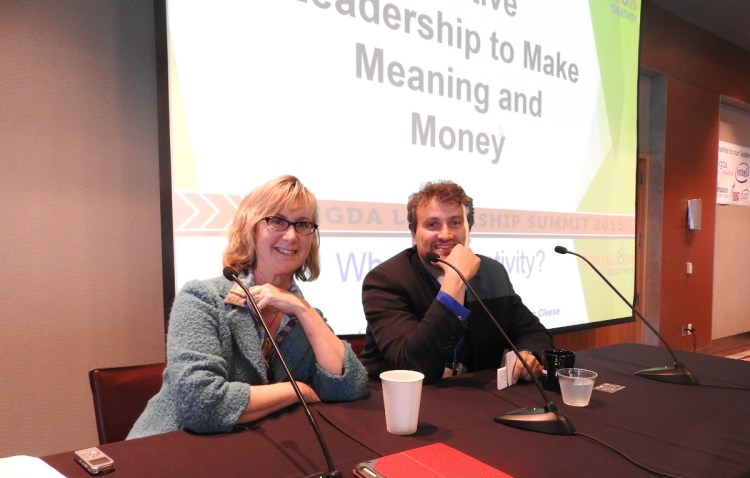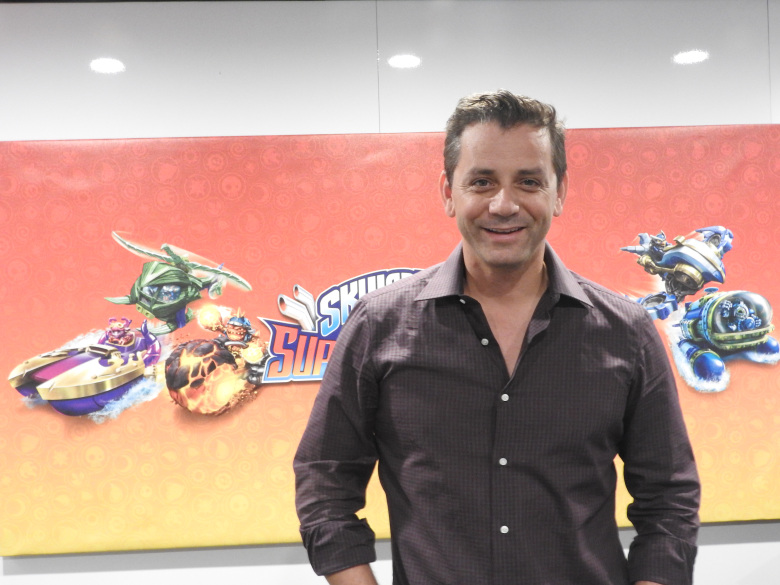GamesBeat: Let’s say that the game industry has a problem. Creativity is not where it should be, and that should be flipped. Monument Valley and games like that should be the ones that everybody aspires to and tries to make happen in a more sustainable way. What is the creative leadership that’s necessary if we’re going to make that assumption?
Gaiser: It doesn’t make financial sense that we’re not taking more risks. Any studio that is not creating diverse content for diverse audiences is leaving money on the table. The indies are leading the way. They’ve proven that diverse audiences play games that are designed for them.
Getting to the creative leadership issue, the courage to take risks is a value of creativity. Leading creatively—This is a more formal definition. This type of leadership leads with creative intelligence and is supported by intellectual intelligence – literal, logical, linear thinking. It’s flipping traditional corporate leadership on its head.
Why are we only serving the shareholders and the board members? Our job is to serve the employees and the customers as well. When we’re doing that, we are setting the behavior to inspire in everything we do. Leadership is behavior, not authority. Under creativity, I see as the pillar, you have inclusivity. You have diverse opinions and people. You have the courage to take risks and right action in the moment. Support, encouragement, kindness. Curiosity is the biggest. Curiosity not just to do something the way it’s always been done, but to always be questioning how to do something better.
When the economy crashed, I crashed too. We had to do some layoffs. We’d been riding high for a decade. I was scared to death. But then I thought that we could do the opposite of what’s done, which is how we did it for the decade that we succeeded. Instead of taking the employees’ keys and shutting down their computers and treating them inhumanly, the management team devised a plan to, moment by moment, support them throughout the entire process.
That gave continuing employees their role: to support these people for the next three days. Instead of the corporate way, where you have your head down and don’t know what to say, everybody was still connected. Everybody had a part to play. We can do that with HR. Their job should be to inspire, not to go through issues all the time. Everything, in my opinion, needs to be redesigned so that we’re finally serving the collective.
Bernstein: To your point about serving shareholders, Electronic Arts makes a tremendous amount of money, as does Activision, making products that are marginally creative. They have taken what they’ve done before and marginally improved it. There is a ceiling to that. A crash is inevitable. You’re now seeing a lack of financing and M&A activity for games. I was fortunate to have worked back in the days when you could get a game company funded.
Why is that? Maybe it’s the market? Bullshit. It’s not the market. The market’s good. I can tell you that the market in all these other areas, all these other sectors, is doing well. There’s about a trillion and a half in cash earmarked for acquisitions. So what is it? It’s creativity. It’s the fact that there’s not enough core innovation coming from that inner place associated with design and creation. The whole process of creation is broken. We’re not tapping into it. It’s not supported by anyone in the organization, whether it’s design or HR.
One thing that was great about Popcap is they had these design jams. It was a great company, a very creative company, and it still is, but now they’re part of EA, so no comment. The point is, it’s there. You can do it. But you need to structure your organization in such a way that you’re fostering creativity from within people in your organization.
You’re starting to see Fortune 500 companies that are run by women, run by people of color. But it’s still very homogenized. The structure is still the same. From the top, continue to work on these product lines and iterate on revenue moving forward. Don’t revolutionize. Don’t think outside what you’re doing. That’s the problem. When tap into the creative potential of your employees, who are now more diverse than ever—The first time I went to GDC it was all just a bunch of white guys. It’s completely revolutionized at this point. But we’re not tapping into the potential of what these folks can bring to the table. We challenge leadership, collectively, to do that, for the sake of having a viable games industry.
Gaiser: Creative leadership, in a short of way of saying it, welcomes diverse people and perspectives for diverse and inspiring products. The keynote this morning was great. We’re all saying the same thing in different words. Even creative leadership–Whether you call it conscious leadership, facilitative, servant leadership, it’s all the same thing.
She said that in order for people to give all of themselves, they need to feel welcomed. They need to feel valued. Another thing creative leadership does, it encourages authenticity. People can truly let down their guards to collaborate. They bring their whole selves to the job, to the creation. And as an added bonus, we’re all creative. In our games, every single person brings their own unique creativity. Every game reflects that. It’s such a sense of pride that everyone had. Then, when our fans gave us testimonials – thousands over the decade – they said they were so inspired that they went on to become scientists, technologists, a NASA engineer, all these things. It gave them extrinsic satisfaction and it gave us intrinsic satisfaction. There’s nothing better than that.
We had a vision. We didn’t want pink games for girls. We just pushed. The system didn’t include us, so we redesigned it from the very beginning, and to great results. We had inspired employees, inspired customers, consecutive award-winning products, and increasing revenues for a decade. You can’t argue with that. I didn’t realize how different that was from the way other companies operated. We were in a little bubble.
GamesBeat: There’s a lot of room for disagreement here. How much creativity can a company afford? How do you foster it? An example I like starts with a young guy, an architecture student. He’s an artist. He goes to work at an advertising agency. He helps with a lot of their creative work and feels like very much a creative person at heart. He’s eventually appointed the CEO of Activision Publishing. His name’s Eric Hirshberg. He runs the company that produces games like Destiny and Call of Duty and Skylanders.
Somewhere along the way, he went from creative to corporate. He’s now part of a company that everybody tends to bring up when they say there’s a problem with creativity in this industry. I bring that up to raise the question: Is there a problem in the industry, or is this an example of the industry working creatively?
Bernstein: He’s doing a one-plus on the creativity side. It’s important to give him credit for that. There’s a greater market opportunity, though. There’s a greater variety of products that could be tapped into. The problem is, when you start operating at the level of a public company, you’re beholden to shareholders and making sure you hit your numbers. That creates a fear of going too far off the cliff. A lot of executives are driven by that, or at least have that in their back pocket.
The courage to drop all your cards on the table is very difficult, especially if you’re running a large public company. It’s impossible. The shareholders will scald you. So it does have to come from—I don’t think that level ingenuity is going to happen.
Another example might be what’s happening in VR right now. Are you seeing innovations in VR happening within the large studios? No. They’re playing a wait-and-see game. I’ve seen some great demos and games coming out of smaller studios. They point to an interest in innovating and tapping into creativity that’s untethered from the things that keep us from being creative. Things like, “Okay, I have to deliver quarterly results better than the last ones.”
In answer to your question, he’s done a great job of stepping a bit outside the box. But there’s a world of other boxes. Right now we’re talking about that world and the opportunities there.





